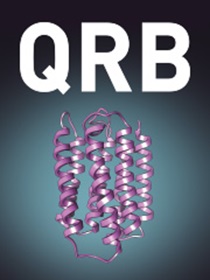弥合体外和体内RNA折叠之间的差距
IF 7.2
2区 生物学
Q1 BIOPHYSICS
引用次数: 94
摘要
破译折叠途径和预测复杂三维生物分子的结构是阐明生物功能的核心。RNA是单链的,这使得它可以自由折叠成复杂的二级和三级结构。这些结构赋予RNA执行复杂化学和功能的能力,从酶活性到基因调控。考虑到RNA参与了许多基本的细胞过程,了解它在体内如何折叠和功能是至关重要的。在过去的几年中,已经开发出了在体内和全基因组范围内探测RNA结构的方法。这些研究揭示了RNA在体内和体外往往采用非常不同的结构,并为RNA生物学提供了深刻的见解。然而,体外和体内方法都有局限性:在复杂和不受控制的细胞环境中进行研究,很难深入了解RNA折叠途径和热力学,体外研究往往缺乏直接的细胞相关性,这给我们对体内RNA折叠的认识留下了空白。在模拟细胞环境的条件下,RNA结构和功能的生物物理和机制研究正在填补这一空白。迄今为止,大多数人工细胞质使用各种聚合物作为分子拥挤剂和一系列小分子作为辅质。在这种类体内条件下的研究正在产生新的见解,例如功能性rna的协同折叠和核酶活性的增加。这些观察结果部分是由分子拥挤效应和与其他分子的相互作用造成的。在这篇综述中,我们报告了体外和体内RNA折叠的里程碑,并讨论了正在进行的实验和计算工作,以弥合这两种条件之间的差距,以便了解RNA在细胞中如何折叠。本文章由计算机程序翻译,如有差异,请以英文原文为准。
Bridging the gap between in vitro and in vivo RNA folding
Abstract Deciphering the folding pathways and predicting the structures of complex three-dimensional biomolecules is central to elucidating biological function. RNA is single-stranded, which gives it the freedom to fold into complex secondary and tertiary structures. These structures endow RNA with the ability to perform complex chemistries and functions ranging from enzymatic activity to gene regulation. Given that RNA is involved in many essential cellular processes, it is critical to understand how it folds and functions in vivo. Within the last few years, methods have been developed to probe RNA structures in vivo and genome-wide. These studies reveal that RNA often adopts very different structures in vivo and in vitro, and provide profound insights into RNA biology. Nonetheless, both in vitro and in vivo approaches have limitations: studies in the complex and uncontrolled cellular environment make it difficult to obtain insight into RNA folding pathways and thermodynamics, and studies in vitro often lack direct cellular relevance, leaving a gap in our knowledge of RNA folding in vivo. This gap is being bridged by biophysical and mechanistic studies of RNA structure and function under conditions that mimic the cellular environment. To date, most artificial cytoplasms have used various polymers as molecular crowding agents and a series of small molecules as cosolutes. Studies under such in vivo-like conditions are yielding fresh insights, such as cooperative folding of functional RNAs and increased activity of ribozymes. These observations are accounted for in part by molecular crowding effects and interactions with other molecules. In this review, we report milestones in RNA folding in vitro and in vivo and discuss ongoing experimental and computational efforts to bridge the gap between these two conditions in order to understand how RNA folds in the cell.
求助全文
通过发布文献求助,成功后即可免费获取论文全文。
去求助
来源期刊

Quarterly Reviews of Biophysics
生物-生物物理
CiteScore
12.90
自引率
1.60%
发文量
16
期刊介绍:
Quarterly Reviews of Biophysics covers the field of experimental and computational biophysics. Experimental biophysics span across different physics-based measurements such as optical microscopy, super-resolution imaging, electron microscopy, X-ray and neutron diffraction, spectroscopy, calorimetry, thermodynamics and their integrated uses. Computational biophysics includes theory, simulations, bioinformatics and system analysis. These biophysical methodologies are used to discover the structure, function and physiology of biological systems in varying complexities from cells, organelles, membranes, protein-nucleic acid complexes, molecular machines to molecules. The majority of reviews published are invited from authors who have made significant contributions to the field, who give critical, readable and sometimes controversial accounts of recent progress and problems in their specialty. The journal has long-standing, worldwide reputation, demonstrated by its high ranking in the ISI Science Citation Index, as a forum for general and specialized communication between biophysicists working in different areas. Thematic issues are occasionally published.
 求助内容:
求助内容: 应助结果提醒方式:
应助结果提醒方式:


